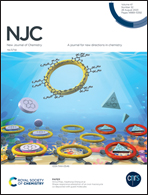Pillar[5]arenes-based high-Tg thermosets for the capture of volatile organic compounds†
Abstract
Volatile organic compounds (VOCs) continue to be one of the biggest problems for air quality and it is becoming increasingly urgent to find new systems capable of limiting their concentration in the atmosphere. Thanks to their capacity to recognize halogenated derivatives, Pillar[5]arenes were used to form high performance thermosets able to absorb chlorine and bromide-based VOCs. Initially, poly(2-vinyl-4,4-dimethylazlactone) featuring different chain length were synthetized and modified by ring opening reaction by mono-amino substituted P[5]A. The high-Tg polymers obtained were then crooslinked by isophore diamine to form high performance materials featuring Tg up to 150 °C and storac modulus G′ up to 85 MPa. The ability of P[5]A cavities to capt VOCs was investigated by vapor sorption tests in presence of dichloromethane, 1,2-dibromoethane, dibromochloromethane and 1,1,2,2-tetrachloroethane. The P[5]A-based thermosets shown to be efficient to absord these carcenogenic VOCs and, this efficiency depends on the affinity of cavities for the studied VOCs, proving that these new generation of thermosets seems to be selective towards certain VOCs.
![Graphical abstract: Pillar[5]arenes-based high-Tg thermosets for the capture of volatile organic compounds](/en/Image/Get?imageInfo.ImageType=GA&imageInfo.ImageIdentifier.ManuscriptID=D3NJ02422A&imageInfo.ImageIdentifier.Year=2023)


 Please wait while we load your content...
Please wait while we load your content...